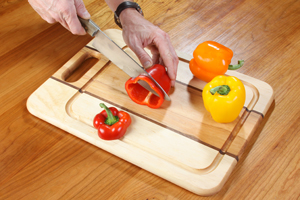
Looking at making some cutting boards for family for the holidays. Understand it is OK to use maple, cherry and walnut for such projects. Are there any wood types to stay away from, ie: ash, purpleheart, birch, padauk, red oak, ipe (have some scraps to use up), or yellow pine? Any others that are no-no’s? – Doug Selfe
Chris Marshall: Wood toxicity is a good factor to keep in mind when choosing species that will be included in food-related projects. Here’s a link to a chart that lists wood species with potential toxic characteristics (click here), and there are many others available through an Internet search. I would also think in terms of hardness, porosity and taste when considering which ones to use for cutting boards. I would avoid open-pored woods like ash and red oak, which will be harder to keep clean from food stains. Pine might impart a resinous taste, and it’s soft so will show cutting scars from knives more easily than a harder wood like maple. I’d stick with the old close-pored standbys for cutting boards: maple, beech and birch, and use other woods sparingly for adding color and contrast to those projects. The important thing with a cutting board is that it does its job well — it should be hard, washable, nontoxic and dimensionally stable.
Tim Inman: I’d avoid oak. Reason? The tannins in oak can react with metals to make a dark purple/black stain. Walnut might have some disagreeable flavor contributions, if the food were left in contact with it for a long time. Not really an issue, but at least a consideration. I’d recommend trying to select wood types which have similar expansion and contraction coefficients. That way, your cutting board will be less apt to warp and distort over time. I’d stay with all hardwoods. Use a waterproof glue. Cutting boards that actually get used also get washed. It isn’t much fun to watch your favorite cutting board fall apart in the washing up pan. Of course, tell your giftees not to put the cutting board in the dishwasher. (Voice of experience here….)





